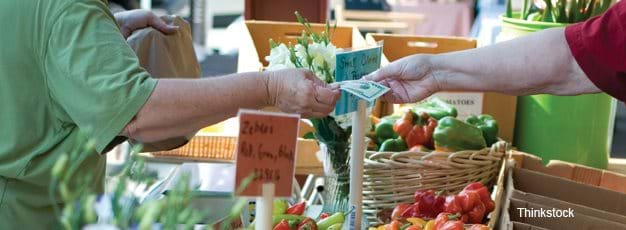Urban Areas Prove Profitable for Farmers Selling Directly to Consumers

Farmers who sell directly to consumers represent a small fraction of the farm sector, and their direct sales accounted for 0.4 percent of the sector’s total sales in 2007. But their numbers and importance are growing in response to demand for locally grown food. The number of U.S. farms selling directly to consumers through farmers’ markets, roadside stands, and pick-your-own operations grew by 104.7 percent between 1997 and 2007, while the value of direct sales increased 47.6 percent. In 2007, $1.2 billion of farm products were sold directly to consumers by 136,800 farms, or 6 percent of all U.S. farms. Direct sales are highest in the urban corridors in the Northeast and on the West Coast.
Urban markets seem to be especially targeted by farmers engaged in direct sales. Fully 84 percent of farms that sell directly to consumers are located in metropolitan counties or in adjacent rural counties, and these farms accounted for 89 percent of the direct sales income reported by farm operators in 2007. Average direct sales value per farm decreased for farms located progressively farther from urban centers: from $10,987 for farms located in metropolitan counties, to $6,767 for farms in adjacent rural counties, and to $6,090 for farms in remote rural counties.
Small farms (annual sales less than $50,000) represent 85 percent of all farms reporting income from direct sales to consumers. Their direct sales are low, averaging only about $3,200 per year, but represent 35 percent of their total sales volume. Although it is less common for medium and large farms to sell directly to consumers, those that do together average $40,000 in annual direct sales. Still, direct sales represented only 11 percent of these participating medium and large farms’ total sales in 2007 (see chart).
By selling directly to consumers, farmers are able to retain or transfer some of the value added normally captured by other transportation, processing, and retailing firms in the food supply chain. Additionally, data show that 40 percent of direct-sales producers are classified as beginning farmers who have less than 10 years of farming experience.
Among products sold through direct markets, vegetables and fruit need little processing and, therefore, are most easily sold directly to consumers, either for immediate consumption or for home preparation. Almost half of all vegetable and melon farms and one-sixth of fruit and nut farms sell directly to consumers.
Local Food Systems: Concepts, Impacts, and Issues, by Stephen Martinez, Michael S. Hand, Michelle Da Pra, Susan Pollack, Katherine Ralston, Travis Smith, Stephen Vogel, Shellye Clark, Luanne Lohr, Sarah A. Low, and Constance Newman, USDA, Economic Research Service, May 2010


